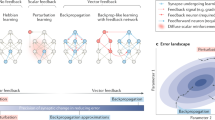Abstract
This paper describes a neural network model of the retinal responses to stimuli whose architecture is inspired by neurophysiological data. Suitable assumptions are identified which enable the development of a simple model for an individual X-type ganglion cell using backpropagation. This is then used to make a model of retinal processing. We present here our model of the individual ganglion cells and the underlying assumptions. We show that backpropagation leads to a model which is similar to the mathematical descriptions of retinal processing advanced by Marr. We present the results obtained when our model is used to simulate the effect of retinal processing on images. Empirical results about the speedups obtained when this model is implemented on parallel architectures are also reported.
Similar content being viewed by others
References
Barrow HG (1987) Learning receptive fields. In: Proc IEEE 1st Int Conf on Neural networks (vol 4). pp 115–121
Baylor DA, Fuortes MGF, O'Bryan PM (1971) Receptive fields of single cones in the retina of turtle. J Physiol (Lond) 214:256–294
Braham R, Hamblen JO (1990) The design of a neural network with biologically motivated architecture. IEEE Trans Neural Networks 1:251–262
Buser P, Imbert M (1992) Kay RH, (trans). Vision. MIT Press, Cambridge, Mass
Caldwell JH, Daw NW (1978) Effects of picrotoxin and strychnine on rabbit retinal ganglion cells: changes in centre surround receptive fields. J Physiol (Lond) 276:299–310
Daugman J (1983) Six formal properties of two dimensional anisotropic visual filters. IEEE Trans Syst Man Cybern 13:882–887
Daugman J (1988) Pattern and motion vision without Laplacian zero crossings. J Opt Soc Am [A] 5:1142–1148
Dowling JE (1987) Retina, the approachable part of the brain. Harvard University Press, Cambridge, Mass
Enroth-Cugell C, Robson J (1966) The contrast sensitivity of retinal ganglion cells of the cat. J Physiol (Lond) 187:517–522
Grossberg S, Wyse L (1991) Neural network architecture for figure-ground separation of connected scenic figures. Neural Networks 4:723–742
Hubel DO (1988) Eye, brain and vision. Scientific American, New York
Joshi A, Lee CH (1991) On modelling the retina using neural networks. In: Proc Int Joint Conf on Neural Networks'91, Singapore, pp 2343–2348
Kleinschmidt J, Dowling JE (1975) Intracellular recordings from gecko photoreceptors during light and dark adaptation. J Gen Physiol 66:617–648a
Kolb H (1979) The inner plexiform layer in the retina of the cat: electron microscopic observations. J Neurocytol 8:295–329
Lehky SR, Puget A, Sejnowski TJ (1990) Neural models of binocular depth perception. Cold Spring Harbor Symp Quant Biol 55:765–777
Linsker R (1988) Self organisation in a perceptual network. Computer 21:105–117
Mach E (1906) Über den Einfluss räumlich und zeitlich variieender Lichtreize auf die Gesichtswahrnehmung. Sitzungsber Math Naturwiss Kl Kaiser Akad Wiss 115:633–648
Marr D (1982) Vision. Freeman, San Francisco
Marr D, Hildreth E (1980) The theory of edge detection. Proc R Soc London Ser B 207:187–217
Oğuztöreli M (1988) Underlying neural computations for some visual phenomenon. Biol Cybern 60:89–106
Oğuztöreli M (1989) Neural computations in some visual processes. In: Proc 1989 IEEE Int Conf on Systems, Man and Cybernetics, vol 2, pp 664–670
Richter J, Ullman S (1986) Non linearities in cortical simple cells and the possible detection of zero crossing. Biol Cybern 53:195–202
Thibos LN, Werblin FS (1978) The response properties of the steady antagonistic surround in the mudpuppy retina. J Physiol (Lond) 278:79–99
Wallach H (1948) Brightness constancy and the nature of achromatic colours. J Exp Psychol 38:310–324
Watt R (1988) Visual processing: computational psychophysics and cognitive research. Erlbaum, Hillsdale
West RW (1976) Light and electron microscopy of the ground squirrel retina: functional considerations. J Comp Neurol 168:355–377
West RW, Dowling JE (1972) Synapses onto different morphological types of retinal ganglion cells. Science 178:510–512
Author information
Authors and Affiliations
Rights and permissions
About this article
Cite this article
Joshi, A., Lee, CH. Backpropagation learns Marr's operator. Biol. Cybern. 70, 65–73 (1993). https://doi.org/10.1007/BF00202567
Received:
Accepted:
Issue Date:
DOI: https://doi.org/10.1007/BF00202567




